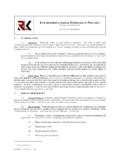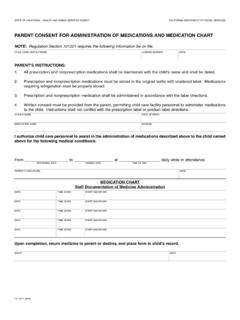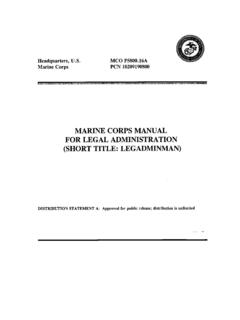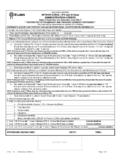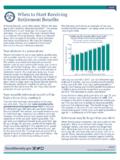Transcription of YOUR DUTIES AS TRUSTEE Guidelines for Trust …
1 your DUTIES AS TRUSTEEG uidelines for Trust Administrationby Layne T. : This memo is for a TRUSTEE under a trust1 that is governed byNevada law and that was originally established as a revocable Trust but which has becomeirrevocable because of the settlor s or surviving settlor s2 death. Perhaps some of these tasks havebeen done by a predecessor TRUSTEE , but we recommend that you review this entire memo. your taskis to administer and distribute the Trust estate3 as directed in the Trust document. This memooutlines your DUTIES as TRUSTEE , and gives a simplified overview of the Trust administration process. In this memo, you and other second-person pronouns refer to the TRUSTEE designated in the trustor appointed under its terms. We , us , and other third-person plural pronouns refer toRushforth Lee & Kiefer LLP, a Nevada limited-liability company doing business as Rushforth Lee& Kiefer LLP If you ever have a question about this memo or about what you should and should notdo, please call to Trust Assets: A TRUSTEE is the person designated in the Trust instrument(or in accordance with the Trust instrument) to be the owner and manager of Trust assets.
2 Personsacting jointly as trustees are called co-trustees, and unless the document creating the Trust specifiesthat DUTIES of each co- TRUSTEE are different, the trustees have equal authority and power. Also, unlessthe Trust document specifies otherwise, co-trustees act by majority vote. For the purposes of thismemo, we will assume that there is one TRUSTEE , and if there are co-trustees, you should confer withus regarding the division of DUTIES and responsibilities among all of the Instrument: Because a TRUSTEE is legally obligated to follow the terms of thetrust instrument, you must read the entire Trust document carefully. Do not sign any documentindicating that you are willing to be bound by the Trust document until you have read andunderstood all of its Appointment: You have authority to act as TRUSTEE as soon as you havecomplied with the terms of the documents regarding your appointment.
3 Because different trustshave different requirements, it is impossible to outline all specific requirements in this memo. 1A Trust is the legally recognized arrangement under which a TRUSTEE owns and manages Trust assets for designatedbeneficiaries. Sometimes, we also use the word Trust to refer to the document that creates the Trust arrangement, butusually we will refer to the document as the Trust instrument , Trust document , Trust agreement , or declaration of Trust . For the purpose of this memo, those terms include any pertinent Trust terms settlor , grantor , and trustor are used interchangeably to refer to the person or persons whooriginally established the Trust . Surviving settlor refers to the last settlor living where there are two or more settlors whocreated the Trust . Deceased settlor refers to the settlor or surviving settlor whose death makes the Trust Trust estate consists of all assets belonging to the Trust , whether they were originally owned by the TRUSTEE ,received under a contractual beneficiary designation (such as under a life insurance policy or other contract providing deathbenefits), or received as a distribution from the settlor s probate are not obliged to engage us for any legal work.
4 If you choose to engage another attorney or firm to assist you,references to we and us should be read as references to the attorney or firm you engage to advise :\FORMS\cm\ DUTIES of a Copyright 1988-2017 by Rushforth Lee & Kiefer LLPYOUR DUTIES AS TRUSTEEPage 2(a)As a general rule however, to become TRUSTEE , you must:(1)Sign a certificate of incumbency 5 indicating that you are theincumbent ( , acting) TRUSTEE and declaring that you are willing to follow the termsof the Trust instrument.(2)Attach to the certificate of incumbency a copy of: (a) your predeces-sor s death certificate; (b) your predecessor s resignation; or (c) declarations fromphysicians stating that your predecessor is incapacitated to the point that he or shecan no longer act as TRUSTEE .(3)Have the certificate of incumbency recorded in the county in whichthe Trust is considered located (often referred to in the documents as the situs ofthe Trust ) and in each county in which real property owned by the Trust is located.
5 (b)You can choose, if you wish, to have your appointment confirmed by theprobate court [NRS ], but normally this formal court proceeding is not necessary. On the other hand, if there is a dispute as to your appointment or qualifications or if youanticipate that some of your decisions may be challenged by beneficiaries, court confirma-tion and a Trust administration proceeding in the probate court may be Steps: There are two notices that we encourage the TRUSTEE to give. (a)Notice to Creditors. If your appointment came as a result of the settlor sdeath, we recommend that you sign a notice to creditors and have it published in anapproved newspaper [NRS ]. The same notice should be mailed by certified mail,return receipt requested, to known creditors, particularly if you do not know the amount oftheir potential claims, if there are insufficient assets to pay them, or if you intend to disputeall or part of their claims.
6 Each Trust beneficiary and each omitted heir should be sent thesame notice because some of them may argue that the deceased settlor owed them money,usually under an alleged contract. The creditors have 90 days in which to file claims, or theclaims become forever barred. (b)Notice of Irrevocability. When a revocable Trust becomes irrevocable (oreven a part of the Trust becomes irrevocable), the TRUSTEE should send a notice to the trustbeneficiaries and to heirs who think they should be beneficiaries explaining that the Trust hasbecome irrevocable and they have 120 days to contest the validity of the declaration of trustor Trust agreement, including any amendments. If this is not done, a beneficiary or omittedheir can bring their contest years Subtrusts in Two-Settlor Trusts: It is common for couples tocreate two-settlor trusts that divide into two or more subtrusts when one of the settlors has died.
7 In many cases, one of the subtrusts will remain revocable, but at least one of the subtrusts willbecome irrevocable, and this memo applies to each irrevocable subtrust created under the terms of5In some states, this is referred to as an Affidavit of Successor TRUSTEE , but the function and purpose are the :\FORMS\cm\ DUTIES of a Copyright 1988-2017 by Rushforth Lee & Kiefer LLPYOUR DUTIES AS TRUSTEEPage 3such a Trust .(a)Instructions regarding the division of the Trust into subtrusts are given in aseparate memo titled Dividing a Trust into Subtrusts after a Settlor s Death . If a copy ofthat memo has not been given to you, request one, or download it from our web (b)To accomplish the intended objectives of a Trust that divides into subtrusts,it is imperative that the division of the Trust be properly documented and that each Trust berespected as a separate entity.
8 Each irrevocable subtrust should have its own taxidentification number, and you will need to file a fiduciary income tax return (IRS Form1041) for each such Trust .(c)As to each irrevocable Trust for which you are both the TRUSTEE and abeneficiary, special care is required in the administration of each subtrust to avoid violatingthe DUTIES of a TRUSTEE , as outlined in subsection of this memo, especially the DUTIES ofloyalty and impartiality. To avoid breaching your DUTIES , it is very important that youregularly confer with us or with other legal counsel and with a certified public accountantwith respect to the administration of the administration : TRUSTEE s DUTIES and Standard of Care: As a fiduciary, you are held to afiduciary standard of care, which generally means that you must take more care with other people sassets than you would your own.
9 The law summarizes these five primary fiduciary DUTIES , which canbe remembered with the phrase A CLIP :(a)You must ACCOUNT to the beneficiaries and keep them informed as to themanagement of Trust assets.(b)You must COMPLY with the Trust instrument and applicable state and federallaw. This includes the duty to pay debts, taxes, and other property expenses, as well as tomake the distributions permitted or required under the Trust instrument.(c)You must be LOYAL to the beneficiaries of the Trust , which means that youcannot make decisions that favor yourself or anyone else more than the Trust s beneficiaries.(d)You must be IMPARTIAL when it comes to different beneficiaries of the Trust (unless the Trust document specifically allows you to favor a beneficiary or group ofbeneficiaries); you cannot take sides.
10 (e)You must be PRUDENT in the investments you make and in the management6 providing this memo, we are not accepting any duty as your legal counsel. That is done only through a formal,written engagement agreement that is signed by :\FORMS\cm\ DUTIES of a Copyright 1988-2017 by Rushforth Lee & Kiefer LLPYOUR DUTIES AS TRUSTEEPage 4of the Trust s You must take ownership and control of all assets9 belonging to thetrust, and you must evaluate the prudence of either retaining those assets or converting themin to more appropriate : Under Nevada law, a TRUSTEE can convey good title except as restricted bythe document that transferred title to the TRUSTEE . [NRS ] Of course, you are liable to thebeneficiaries if you breach your duty as a TRUSTEE by failing to act prudently [NRS et seq.]or by failing to follow the Trust instrument.
